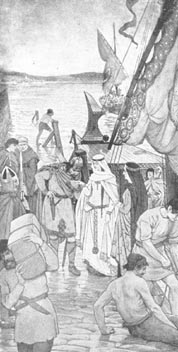
Edward the Atheling or “Royal Prince” (1016 –1057) was the eldest son of King Edmund II Ironside of England. He fled to Hungary during the reign of Canute (1016 – 1035) where he married Agatha, who is said by some sources to be daughter of King Stephen. Their daughter, St. Margaret the Exile, was born in Hungary in 1045. After the death of her father in 1057, St. Margaret arrived at the court of King Edward the Confessor in England.
Ten years later, following the defeat of Harold Godwinson at Hastings, St. Margaret was in exile again; and this time she fled to Scotland. The photograph shows the arrival of St. Margaret at Queensbury in 1066. She was married against her wishes to King Malcolm III Cænmore of Scotland at Dunfermline Abbey, Fife, Scotland in 1068. Her unlearned and boorish husband grew daily more graceful and Christian under the queen’s graceful influence.
Margaret was a much loved and very devout queen. She had travelled widely in Europe and when she came to Scotland she was determined to change the manner of the court both in fashion and standards of behavior. Nobles were forbidden to fight or get drunk at court and she gave each noble his own drinking cup. Margaret was allowed to use her husband's money to help the poor by giving them food, shelter and clothing. She also encouraged trade with foreign merchants. Under her influence, life became more civilized. She also founded many monasteries and tried to bring her Roman Church close together with the Celtic church.
St. Margaret died on November 16, 1093, at Edinburgh Castle, Scotland. Her body was interred at Dunfermline Abbey, Fife, Scotland; but her remains were later removed to Scoria, Spain and her head to Domain, France.
St. Margaret was canonised in 1250; and her feast day in Scotland is November 16, the anniversary of her death.
St. Margaret and King Malcolm III Cænmore of Scotland had eight children: